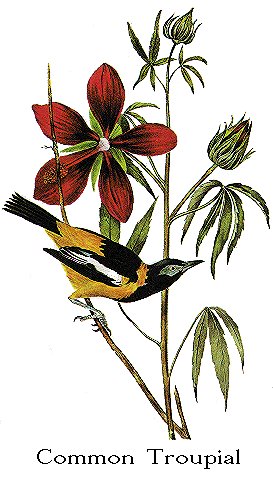
| NEW SPECIES.
NOT IN MY SYNOPSIS. |
Next >> |

Family |
COMMON TROUPIAL. [Troupial.] |
| Genus | ICTERUS VULGARIS, Daud. [Icterus icterus.] |
This handsome bird was first observed at Charleston, South Carolina, by my
son JOHN WOODHOUSE, who shot and figured a male the size of nature; the bird
when first seen was perched on the point of a lightning-rod close by the house
of my friend the Reverend JOHN BACHMAN, D. D. A few days afterwards others were
seen, but although a female was shot, it fell in the river and was lost. I am
informed that since that period, small groups of four or half a dozen make their
appearance in the same city, and on the neighbouring islands. It is a common
species in almost every portion of South America, where, according to DAUDIN,
they associate in large flocks, and build a large pensile nest. This bird is
very easily tamed, and becomes so gentle as to suffer itself to be handled by
its master. The sharpness of their bill, however, renders them somewhat
disagreeable as pets, for in many instances they have been known to inflict
severe wounds, especially on children.
COMMON TROUPIAL, Icterus vulgaris, Daudin.
COMMON TROUPIAL, Coracias xanthornus, Scopoli.
COMMON TROUPIAL, Yellow and black Pye, Catesby. (Appendix.)
COMMON TROUPIAL, Banana Bird, Albin. Ave. II. tom. 40.
COMMON TROUPIAL, Le Troupiale vulgaire, Button, Pl. Enl. 532.
10, 12 3/4.
Observed occasionally at and near Charleston, S. C. Common in South
America.
Male.
Total length 10 inches; alar extent 12 3/4. Bill, a patch of skin around
the eye and reaching the edge of the upper mandible, as well as the legs and
feet, blue. Eyes bright yellow, inclining to silvery; claws black. The whole
head, neck and upper breast, as well as the back, scapulars and primary quills,
jet black, with bluish reflections on the head. Rump, upper and lower
tail-coverts, as well as the whole under part of the body, and a collar around
the neck, as well as a patch on the wings, black; pinion of a bright
yellowish-orange colour; tail even and black. The secondary coverts largely
tipped, and the quills margined with white, forming a very conspicuous patch of
that colour; second quill longest. Wing from flexure 4 1/8 inches; bill along
the ridge 1 (1 1/2)/8, along the edge rather more than 1 1/4; tarsus (1 1/2)/8;
hind toe 1/2, its claw 1/2; middle toe 1, its claw 3/8. Tarsus and feet, as
well as the claws, strong and well adapted to their habits.
| Next >> |